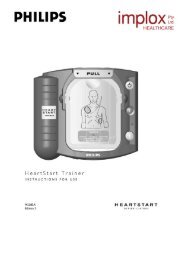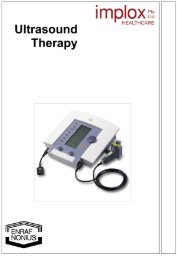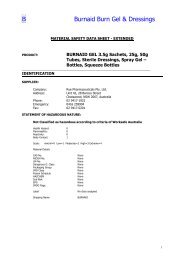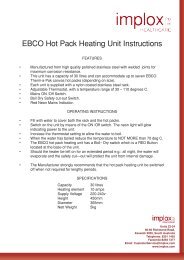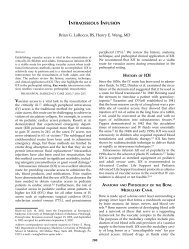Low and medium Frequency Electrotherapy - Implox
Low and medium Frequency Electrotherapy - Implox
Low and medium Frequency Electrotherapy - Implox
Create successful ePaper yourself
Turn your PDF publications into a flip-book with our unique Google optimized e-Paper software.
3.4.2 Application of interferential therapy<br />
Application point for therapy may lie on the surface of the body, or in deeper-lying tissues.<br />
Due to the higher frequency <strong>and</strong> the absence of galvanic effects, <strong>medium</strong>-frequency alternating current is suitable for<br />
treatment of deeper-lying tissues (muscles, tendons, burs or periosteum).<br />
The selected application method will depend on the application points. The application methods are as follows:<br />
• pain-point or trigger-point application,<br />
• nerve application;<br />
• (para) vertebral application;<br />
• transregional application;<br />
• muscular application (see Chapter 5).<br />
The present range of Enraf-Nonius equipment offers five methods for interferential therapy:<br />
1. two-pole (bipolar) method;<br />
2. four-pole (tetrapolar) method (Classic Interferential without vector);<br />
3. four-pole method with Dipole vector (manually adjustable);<br />
4. four-pole method with Dipole vector (automatic);<br />
5. four-pole method with Isoplanar vector<br />
3.4.2.1 The two-pole method<br />
In this method two electrodes are used <strong>and</strong> superimposition of the two alternating currents takes place within the<br />
equipment. The current leaving the equipment is a fully modulated alternating current.<br />
In the two-pole method the modulation depth is always 100% (Fig. 15).<br />
Fig. 15.<br />
Bipolar interferential therapy<br />
3.4.2.2 The four-pole method (Classic Interferential)<br />
In this method four electrodes are used, <strong>and</strong> two unmodulated currents leave the equipment. Interference occurs<br />
where the two currents intersect within the tissue.<br />
The modulation depth depends on the direction of the currents, <strong>and</strong> can vary from 0 to 100%. 100% modulation<br />
depth only occurs at the diagonals (<strong>and</strong> hence at the intersection) of the two currents.<br />
This is, of course, a theoretical situation, based on the assumption that the tissue is homogeneous. In the real<br />
situation, the tissue is heterogeneous, so that the intensity of the two channels has to be used to get the 100%<br />
modulation depth (Fig. 16). This can also be used to compensate for differences in sensation occurring under the<br />
electrode pairs.<br />
17





